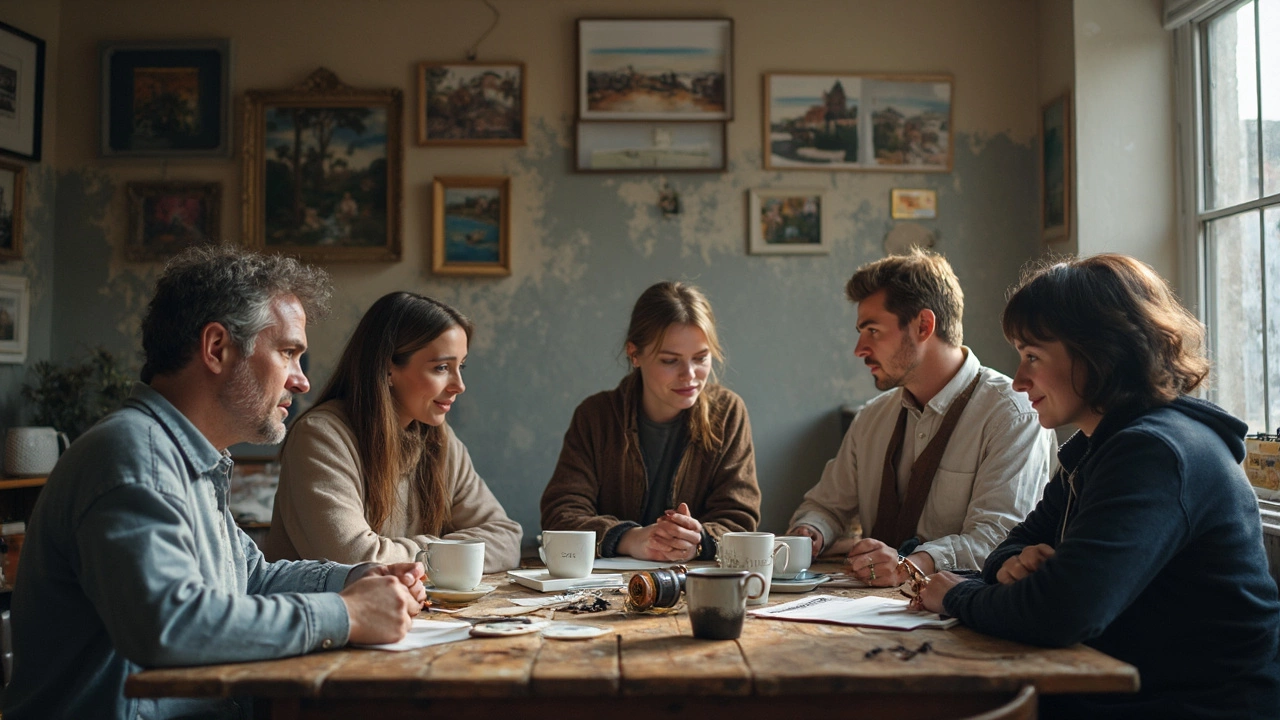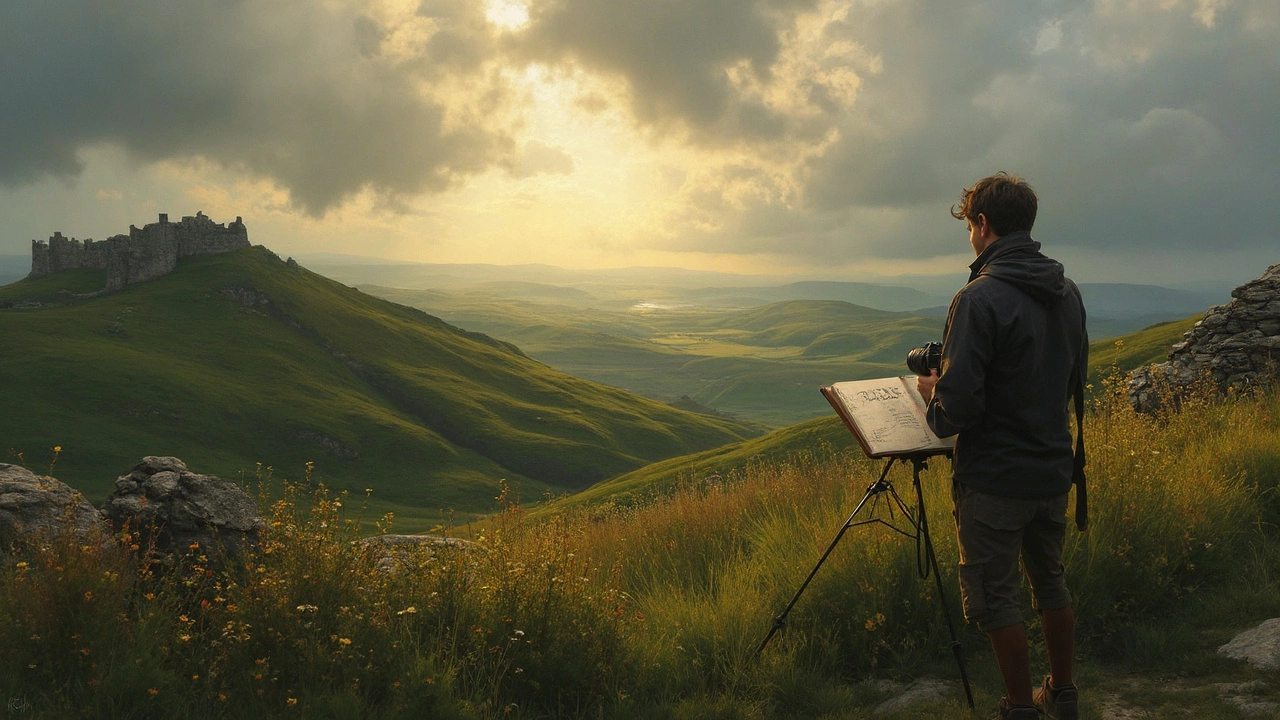Photographers love to argue about what makes an image 'fine art.' Here’s the simple truth: it’s not about the latest camera or perfect lighting. Fine art photography is where ideas come first. The person behind the camera has a vision—something they want to say or show—and every choice, from framing to editing, backs up that message.
This isn’t just about taking a cool shot. In fine art photography, you’re more like a painter or a writer. Each photo starts with a concept, not a lucky moment. Think about what you want people to feel, question, or notice when they see your work. Your goal is to make viewers pause and wonder, even if they don’t get it at first glance. That’s the spark that sets fine art photography apart from quick snapshots or commercial shoots.
- Fine Art Photography vs. Standard Photography
- It All Starts with Intent
- Developing a Personal Style
- Telling Stories through Images
- Tips for Creating Fine Art Photos
- Common Myths and Mistakes
Fine Art Photography vs. Standard Photography
It’s easy to mix up fine art photography with regular snapshots or commercial shoots, but the differences are clearer than people think. With standard photography, most of the time, you’re documenting an event, a scene, or a person. Think of birthdays, weddings, landscapes—those times you just want to capture what’s in front of you. A lot of commercial work, like fashion or product photography, is about showing the viewer exactly what’s there, usually for a client or a job.
Fine art photography flips the script. The main thing is the idea or emotion the photographer wants to share. It’s less about the subject itself and more about what the photo means. You’re not just showing a tree—you’re showing how that tree makes you feel or what it symbolizes. Sometimes the subject isn’t even obvious because the focus is on the message, not the object. Fine art shots are usually part of a series or a project with a clear theme, while standard photos often stand alone.
What sets fine art photography apart:
- Intent: The photo is guided by a personal vision, not just what's happening in front of the camera.
- Creative Freedom: You’re not trying to please a client, so you can experiment with new angles, editing, or even odd subjects.
- Expression: Every choice—from lens to color—backs up the story or mood you want to share.
Here’s a quick comparison to keep it straight:
| Feature | Fine Art Photography | Standard Photography |
|---|---|---|
| Main Goal | Personal expression, telling a story, sharing a vision | Documenting reality, commercial use, capturing events |
| Audience | Art lovers, galleries, collectors | Clients, general public, family and friends |
| Creative Control | All decisions made by the artist | Often shaped by brief, event, or client needs |
| Editing Style | Lots of creative editing allowed | Usually realistic; less manipulation |
So, when you see a photo that feels more like you’re getting a peek inside someone’s thoughts or moods, that’s usually fine art photography in action. The next time you pick up your camera, ask yourself: ‘Am I just taking a picture, or am I saying something with it?’ That small mindset shift is everything.
It All Starts with Intent
If you want to really get what makes fine art photography different, you have to start with intent. This type of photography is never accidental. It’s planned out, and there’s a message or mood behind every shot. Photographers working in fine art often spend just as much time dreaming up ideas as they do actually shooting the pictures.
Take Cindy Sherman, for example. She’s famous for her self-portraits that look like movie scenes. Each photo is staged and built around a clear intention—she wants viewers to think about identity and stereotypes. Nothing is random, not even the smallest prop.
If you’re starting your own project, begin by asking yourself:
- What do I want people to feel or think when they see my image?
- Why am I taking this photo in the first place?
- What story or concept is the image about?
Intent isn’t just artsy talk—it actually shapes your entire process. From picking your location to editing in a certain way, every decision is grounded in that main idea. Most well-known creative photography has a thought-out vision backing every choice. Plenty of photographers sketch their concept or collect inspiration boards before even touching the camera.
Here’s a quick look at how intent can totally change your approach, compared to shooting snapshots:
| Snapshot | Fine Art Photo |
|---|---|
| Quick, in-the-moment | Planned and deliberate |
| Focus on what you see | Focus on what you want to express |
| May not have a message | Driven by meaning or emotion |
This focus on intent doesn’t mean you need a grand story every time, but your work should show you thought about it. Even a ‘simple’ image in art photography can hit hard if it comes from a real idea or feeling.
Developing a Personal Style
This part trips up a lot of newbies in fine art photography. The truth is, nobody wakes up with a finished personal style. Even famous art photographers spent years just trying stuff out. You spot their work from a mile away because they stuck with what felt honest. That’s the real secret: it takes time, mistakes, and figuring out what looks and ideas you keep coming back to.
So how do you actually develop your own thing? Start by shooting a lot and editing a lot. Certain colors, moods, or subjects will keep popping up in your photos. Pay attention to those. Over time, you’ll notice a pattern—it might be shadowy city streets, dreamy landscapes, or tiny details of everyday life. Your style can grow from what genuinely grabs you, not what you think is trending on Instagram.
Looking at other creative photography doesn’t mean copying. It’s about picking out what you admire, then making it your own. Studying artists like Cindy Sherman or Gregory Crewdson can give you solid clues. Sherman uses self-portraits to turn herself into different characters, while Crewdson stages suburban scenes that look straight out of a movie. Both are honest about what they’re obsessed with, and that clarity is what attracts people to their images.
- Keep a folder (digital or printed) of photos that feel most like "you"—build on these to spot patterns.
- Experiment with techniques: harsh light, long exposures, double exposures, or even shooting on film. Don’t get comfortable too fast.
- Set up small projects for yourself, like a series about one color or a recurring theme. A tight focus helps sharpen your style.
- Don’t delete your failures. Sometimes your odd, unfinished shots show what you’re truly interested in.
Consistency matters if you want people to recognize your work. If your Instagram feed looks like it was shot by a dozen strangers, try narrowing your subjects or sticking to a signature color palette. The more you do in a certain direction, the more confidence you’ll gain—and others will spot your style too.
Here’s a quick look at how top art photography names have identified and stuck to their style:
| Photographer | Signature Style |
|---|---|
| Annie Leibovitz | Dramatic portraits, bold lighting, celebrity culture |
| Viviane Sassen | Colorful abstractions, surreal compositions, African influences |
| Steve McCurry | Vivid colors, emotional storytelling, travel |
The takeaway: personal style isn’t about being weird for the sake of it. It’s about making your fine art photography feel personal—driven by curiosity and a little bit of risk.

Telling Stories through Images
If you’ve ever stopped at a photo and felt like there’s a whole movie packed inside, you’ve seen fine art photography at its best. The photographer isn’t just showing what’s in front of the lens—they’re sharing a story, an emotion, or even a question. The ‘story’ might be obvious, like capturing childhood memories, or more subtle, hinting at feelings like loneliness or hope.
Some of the biggest names in creative photography are obsessed with storytelling. Cindy Sherman, for example, crafts scenes where she becomes different characters, making you wonder about each one’s life. Gregory Crewdson stages entire neighborhoods just to set the right mood, almost like making mini-movies in a single shot. Their images aren’t just pretty—they make you ask, ‘What happened before? What’s next?’
- Think about your own life or interests. What moments or feelings could you turn into a photo?
- Use lighting, colors, props, or even blur and shadows to create a mood.
- Location matters: shooting in your garage at night, for example, gives a different vibe than a sunlit park. Small details count.
- If you work with people, give them simple directions instead of strict poses. Let them move naturally so the scene tells itself.
Even if you’re just starting out, you can push your art photography into storytelling by planning ahead. Jot down your idea, sketch a rough visual, or collect inspiration images online. When you shoot, pay attention to every detail in the frame. It all adds up to your story.
Here’s a wild fact: a 2023 online survey of photography enthusiasts found that 70% felt more connected to images that told a clear story, even if the technical quality wasn’t perfect. People care about the feeling and meaning way more than flawless technique.
Tips for Creating Fine Art Photos
If you want to dive into fine art photography, it helps to have a plan. Great images don’t just pop out of thin air. Here’s how to get intentional and actually build photos that have meaning—without getting lost in technical rabbit holes.
- Start with a concept: Don’t just wander with your camera hoping for inspiration. Think about a theme that interests you, like identity, isolation, or even a color. Write it down. Artists like Cindy Sherman and Andreas Gursky are famous for building entire image series around a single big idea.
- Sketch your shot in advance: Even a rough doodle or a storyboard can help you nail down what you want to say visually. The best creative photography projects often start on paper.
- Choose your location and props on purpose: Everything you include in your frame should connect to your vision. Fine art photographers like Brooke Shaden use everyday thrift store finds to set a mood or support their narrative.
- Work in series for greater impact: One photo is nice, but three or more that explore your subject from different angles tell a way deeper story. Galleries and contests usually expect a body of work instead of a single shot.
- Edit for mood, not perfection: Editing is where your unique voice comes in. Dodge and burn, change colors, get weird if it fits the mood. Even Ansel Adams spent hours in the darkroom shaping the feel of his prints.
- Print your work: Don’t just share on Instagram. Printing brings the image to life, and it’s the standard in art photography exhibitions.
If you’re worried about gear, don't be. You can create fine art photography with a smartphone if that’s all you have. Ideas always matter more than equipment.
| Fine Art Photo Step | Why it Works |
|---|---|
| Concept First | Keeps the project focused and meaningful |
| Work in Series | Shows depth and exploration of an idea |
| Edit for Mood | Builds your personal visual storytelling style |
| Print and Display | Takes your work from screen to gallery-ready |
If you hit a creative wall, look up award-winning portfolios or attend a local fine art photography exhibit. Seeing how others build a story in images will fire up new ideas for your own shots.
Common Myths and Mistakes
A lot of people get caught up in rumors or just plain bad advice about fine art photography. You might even hear something totally wrong from a friend or see it on social media. Let’s cut through that noise and clear up what really matters.
First off, there’s this idea that you must have super expensive equipment to make it in fine art photography. That’s just not true. Sure, good gear can help, but it’s your vision and intent that really count. Some of the most memorable photos have been taken with basic cameras or even phones.
Another myth is thinking that any heavily edited photo is automatically 'fine art.' Editing helps, but it can’t fake meaning. Piling on filters or wild Photoshop tricks won’t turn a random shot into fine art if you haven’t thought through your message.
- Myth: "You need to win gallery shows to be legit." Reality: A lot of creative photography lives online and in self-published books. Recognition is great, but it’s not the only path.
- Myth: "Fine art photography is black and white only." Reality: Color is just as valid, and many artists use bold color for impact.
- Myth: "You must explain your work." Reality: Sometimes, leaving images open to interpretation makes them more powerful.
Now, mistakes—everyone makes them. Here are some big ones to watch out for if you’re starting out:
- Copying someone else’s style too closely. Inspiration is good, but your own ideas make your work stand out.
- Throwing ideas at the wall without any theme. Fine art projects work best when they have a clear purpose or story.
- Ignoring feedback. It stings sometimes, but good feedback helps you grow.
If you’re curious about how these myths mess with beginners, check this out:
| Myth | Percent of Beginners Affected |
|---|---|
| Need expensive gear | 65% |
| Heavily edited equals fine art | 53% |
| Black and white only | 38% |
Don’t let these myths hold you back. Focus on your message, be patient with your process, and remember that fine art photography is about showing your unique way of seeing the world.

